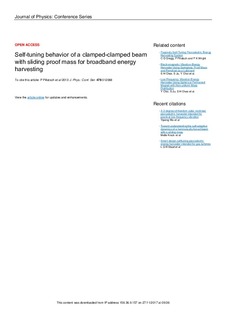| dc.contributor.author | Pillatsch, Pit | |
| dc.contributor.author | Miller, L.M. | |
| dc.contributor.author | Halvorsen, Einar | |
| dc.contributor.author | Wright, P.K. | |
| dc.contributor.author | Yeatman, Eric M. | |
| dc.contributor.author | Holmes, Andrew S. | |
| dc.date.accessioned | 2017-11-28T08:26:50Z | |
| dc.date.available | 2017-11-28T08:26:50Z | |
| dc.date.created | 2013-12-06T15:24:34Z | |
| dc.date.issued | 2013 | |
| dc.identifier.citation | P Pillatsch et al 2013 J. Phys.: Conf. Ser. 476 012068 | nb_NO |
| dc.identifier.issn | 1742-6588 | |
| dc.identifier.uri | http://hdl.handle.net/11250/2468193 | |
| dc.description.abstract | Real world systems rarely vibrate at a single resonance frequency and the frequencies drift over time. Tunable devices exist, but generally need additional energy to achieve frequency adaptation. This means that the benefits in power output from this tuning need to be large enough to power the mechanism itself. Passively self-tuning systems go into resonance without requiring active control. This paper focuses on a passively self-tuning system with a proof mass that can slide freely along a clamped-clamped beam. Under external vibration, the slider moves along the beam until the system goes into resonance. A proof-of-concept design is introduced using either a copper or a steel beam and a 3D-printed ABS thermoplastic proof mass. Successful self-tuning is demonstrated in both cases. The frequencies range from 80 ≠ 140 Hz at accelerations as low as 0.007 g rms. Results show the resonance of the beam and the position of the slider along the beam with time. Furthermore, the dynamic magnification and the proof mass position at resonance are discussed, together with the inherent non-linearities of doubleclamped beam resonators. The findings support the hypothesis that the e↵ect of the ratio between proof mass and beam mass outweighs the Duffing spring sti↵ening e↵ects. | nb_NO |
| dc.language.iso | eng | nb_NO |
| dc.relation.uri | http://iopscience.iop.org/1742-6596/476/1/012068 | |
| dc.title | Self-tuning behavior of a clamped-clamped beam with sliding proof mass for broadband energy harvesting | nb_NO |
| dc.type | Journal article | nb_NO |
| dc.type | Peer reviewed | nb_NO |
| dc.description.version | publishedVersion | nb_NO |
| dc.rights.holder | Content from this work may be used under the terms of the Creative Commons Attribution 3.0 licence. Any further distribution of this work must maintain attribution to the author(s) and the title of the work, journal citation and DOI. Published under licence by IOP Publishing Ltd | nb_NO |
| dc.source.pagenumber | 1-5 | nb_NO |
| dc.source.volume | 476 | nb_NO |
| dc.source.journal | Journal of Physics, Conference Series | nb_NO |
| dc.identifier.doi | 10.1088/1742-6596/476/1/012068 | |
| dc.identifier.cristin | 1073804 | |
| dc.relation.project | Andre: Demand Response project DR-03-01 | nb_NO |
| dc.relation.project | Andre: SIU No. NNA-2008/10004 | nb_NO |
| dc.relation.project | Andre: California Energy Commission 500-01-43 | nb_NO |
| cristin.unitcode | 222,58,4,0 | |
| cristin.unitname | Institutt for mikrosystemer | |
| cristin.ispublished | true | |
| cristin.fulltext | original | |
| cristin.qualitycode | 1 | |
